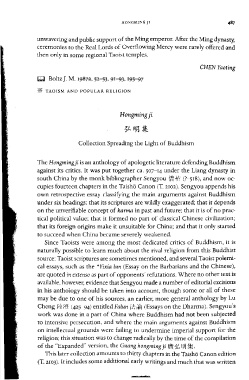Page 527 - The Encyclopedia of Taoism v1_A-L
P. 527
HONGMING JI
unwavering and public support of the Ming emperor. After the Ming dynasty.
ceremonies to the Real Lords of Overflowing Mercy were rarely offered and
then only in some regional Taoist temples.
CHEN Yaoting
m Boltz]. M. 1987a, 52-53, 91 -93, 195-97
* TAOISM AND POPULAR RELIGION
Hongmingji
Collection Spreading the Light of Buddhism
The Hongmingji is an anthology of apologetic literature defending Buddhism
against its critics. It was put together ca. 507-14 under the Liang dynasty in
south China by the monk bibliographer Sengyou f'i"H(i (?-518), and now oc-
cupies fourteen chapters in the Taisho Canon (T. 2102). Sengyou appends his
own retrospective essay classifying the main arguments against Buddhism
under six headings: that its scriptures are wildly exaggerated; that it depends
on the unverifiable concept of karma in past and future; that it is of no prac-
tical political value; that it formed no part of classical Chinese civilization;
that its foreign origins make it unsuitable for China; and that it only started
to succeed when China became severely weakened.
Since Taoists were among the most dedicated critics of Buddhism, it is
naturally possible to learn much about the rival religion from this Buddhist
source: Taoist scriptures are sometimes mentioned, and several Taoist polemi-
cal essays, such as the *Yixia lun (Essay on the Barbarians and the Chinese).
are quoted in extenso as part of opponents' refutations. Where no other text is
available, however, evidence that Sengyou made a number of editorial excisions
in his anthology should be taken into account. though some or all of these
may be due to one of his sources, an earlier, more general anthology by Lu
Cheng I~HW. (425-94) entitled Falun W iJ.ij (Essays on the Dharma). Sengyou's
work was done in a part of China where Buddhism had not been subjected
to intensive persecution, and where the main arguments against Buddhism
on intellectual grounds were failing to undermine imperial support for the
religion; this situation was to change radically by the time of the compilation
of the "Expanded" version, the Guang hongmingji fl ~l.~}j ~.
This later collection amounts to thirty chapters in the Taisho Canon edition
(T. 2103). It includes some additional early Writings and much that was written
.- .. '

